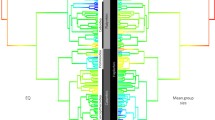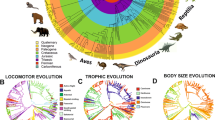Abstract
The feeding niche and the body size of any species are fundamental parameters that constrain the evolution of many other phenotypic characters. Moreover, previous work has shown that body size and diet are correlated, as a consequence of the negative allometry of metabolic rate. Unfortunately, the precise form of the association between body size and diet has never been specified, principally because no suitable cross-species measure of diet has been advanced. Here we develop a measure of diet that is sensitive over the whole spectrum of primate feeding niches, and use this measure to define the relationship between body size and diet for a sample of 72 primate species. Subsequently, we present several examples of how behavioral and ecological hypotheses can be tested by examining the extent to which particular species deviate from the general diet-body size pattern.
Similar content being viewed by others
References
Altmann, S. A., 1974. Baboons, space, time and energy.Amer. Zool., 14: 221–248.
Baldwin, J. D. &J. Baldwin, 1972. The ecology and behavior of squirrel monkeys (Saimiri oerstedii) in a natural forest in western Panama.Folia Primatol., 18: 161–184.
Bateman, A. J., 1948. Intra-sexual selection inDrosophila.Heredity, 2: 349–368.
Bell, R. H., 1971. A grazing ecosystem in the Serengeti.Sci. Amer., 225(1): 86–93.
Bonner, J. T., 1965.Size and Cycle: An Essay on the Structure of Biology. Princeton Univ. Press, Princeton N.J.
Brown, J. L., 1964. The evolution of diversity in avian territorial systems.Wilson Bull., 76: 160–169.
Case, T. J., 1979. Optimal body size and an animal's diet.Acta Biotheoret., 28: 54–69.
Clutton-Brock, T., 1974. Primate social organization and ecology.Nature, 250: 539–542.
———— &P. Harvey, 1977a. Species differences in feeding and ranging behavior in primates. In:Primate Ecology,T. H. Clutton-Brock (ed.), Academic Press, London, pp. 557–584.
———— & ————, 1977b. Primate ecology and social organization.J. Zool., Lond., 183: 1–39.
———— & ————, 1979. Comparison and adaptation.Proc. Royal Soc., B, 205: 547–565.
————, ———— &B. Rudder, 1977. Sexual dimorphism, socionomic sex ratio and body weight in primates.Nature, 269: 797–800.
Crook, J. H., 1964. The evolution of social organization and visual communication in the weaver birds (Ploceinae).Behav. Supple., 10: 1–178.
————, 1972. Sexual selection, dimorphism and social organization in the primates. In:Sexual Selection and the Descent of Man, 1871–1971.B. G. Campbell (ed.), Aldine, Chicago, pp. 231–281.
Davidge, C., 1978. Ecology of baboonsPapio ursinus at cape point.Zool. Afr., 13: 329–350.
Denham, W. W., 1971. Energy relations and some basic properties of primate social organization.Amer. Anthropol., 73: 77–95.
DeVore, I., 1963. Comparative ecology and behavior of monkeys and apes. In:Classification and Human Evolution,S. L. Washburn (ed.), Werner-Gren Foundation, New York, pp. 301–319.
Fleagle, J. G. &R. A. Mittermeier, 1980. Body size and comparative ecology of seven surinam monkeys.Amer. J. Phys. Anthropol., 52: 301–314.
Fogden, M. A., 1974. A preliminary study of the western tarsier. In:Prosimian Biology,G. Doyle &A. C. Walker (eds.), Pittsburgh Press, Pittsburgh, pp. 151–165.
Fooden, J., 1964. Stomach contents and gastro-intestinal proportions in wild-shot Guianan monkeys.Amer. J. Phys. Anthropol., 22: 227–231.
Galdikas, B. M. F. &G. Teleki, 1981. Variations in subsistence activities of male and female pongidsCurr.Anthropol., 22: 241–256.
Gaulin, S. J. C., 1979. A Jarman-Bell model of primate feeding niches.Human Ecol., 7: 1–20.
———— &C. K. Gaulin, 1982. Behavioral ecology ofAlouatta seniculus in Andean cloud forest.Int. J. Primatol., 3: 1–32.
———— &M. Konner, 1977. On the natural diet of primates, including humans. In:Nutrition and the Brain, Vol. 1,R. Wurtman &J. Wurtman (eds.), Raven Press, New York, pp. 1–86.
---- &J. A. Kurland, n.d. Ecological tactics in monogamy: mating system body weight and diet among primates.Amer. J. Primatol. (under review).
———— &L. Sailer, 1984a. Are females the ecological sex?Amer. Anthropol., 86: 111–119.
———— & ————, 1984b. Sexual dimorphism among the primates: the relative impact of allometry and sexual selection.Int. J. Primatol., 5: 515–535.
Gautier-Hion, A., 1980. Seasonal variations of diet related to species and sex in a community ofCercopithecus monkeys.J. Anim. Ecol., 49: 237–269.
———— &J. P. Gautier, 1978. Le singe de brazza: Un strategie original.Zeitschrift Tierpsychol., 46: 84–104.
Geist, V., 1974. On the relationship of social organization and ecology in ungulates.Amer. Zool., 14: 205–220.
Gittens, S. P., 1982. Feeding and ranging in the agile gibbon.Folia Primatol., 38: 39–71.
Haddow, A. H., 1952. Field and laboratory studies of the African monkey,Cercopithecus ascanius Schmidti Matschie.Proc. Zool. Soc., Lond., 122: 297–394.
Happel, R. E., 1982. Ecology ofPithecia hirsuta in Peru.J. Hum. Evol., 11: 581–590.
Harvey, P. H. &G. M. Mace, 1982. Comparisons between taxa and adaptive trends: Problems of methodology. In:Current Problems in Sociobiology,King's College Sociobiology Group (eds.), Cambridge Univ. Press, Cambridge, pp. 343–361.
Hazama, N., 1964. Weighing wild Japanese monkeys in Arashiyama.Primates, 5: 81–104.
Islam, M. A. &K. A. Husein, 1982. A preliminary study of the ecology of the capped langur.Folia Primatol., 39: 145–159.
Iwamoto, T., 1982. Food and nutritional condition of free-ranging Japanese monkeys on Koshima islet during winter.Primates, 23: 153–170.
Jarman, P. J., 1974. The social organization of antelope in relation to their ecology.Behaviour, 58: 215–267.
————, 1982. Prospects for interspecific comparison in sociobiology. In:Current Problems in Sociobiology,King's College Sociobiology Group (eds.), Cambridge Univ. Press, Cambridge, pp. 323–342.
Jolly, A., 1972.The Evolution of Primate Behavior. MacMillan, New York.
Kern, J. A., 1964. Observations on the habits of the proboscis monkey,Nasalis larvatus wurmb, made in the Brunei Bay area, Borneo.Zoologica, 49: 183–192.
Kinzey, W. G., 1981. The titi monkey, genusCallicebus. In:Ecology and Behavior of Neotropical Primates, Vol. 1,A. F. Coimbra-Filho &R. A. Mittermeier (eds.), Academia Brasilieira de Ciencias, Rio de Janeiro, pp. 241–276.
Kleiber, M., 1961.The Fire of Life. Wiley, New York.
Koganezawa, M., 1975. Food habits of the Japanese monkey,Macaca fuscata, in the Boso mountains.Contemporary Primatology, Karger, Basel.
Kurland, J. A. &S. J. C. Gaulin, 1984. The evolution of male parental investment: Effects of genetic relatedness and feeding ecology on the allocation of reproductive effort. In:Primate Paternalism,D. M. Taub (ed.), Van Nostrand Reinhold, New York, pp. 259–308.
Leutenegger, W. &J. Cheverud, 1982. Correlates of sexual dimorphism in primates: Ecological and size variables.Int. J. Primatol., 3: 387–402.
Milton, K. &M. L. May, 1976. Body weight, diet and home range area in primates.Nature, 259: 459–462.
Mittermeier, R. A. &M. G. M. van Roosmalen, 1981. Preliminary observations on habitat utilization and diet in eight Surinam monkeys.Folia Primatol., 36: 1–39.
Mori, A., 1979. Analysis of population changes by measurement of body weight in the Koshima troop of Japanese monkeys.Primates, 20: 371–397.
Mostellor, F. &J. W. Tukey, 1977.Data Analysis and Regression. Addison-Wesley, Reading, Mass.
Napier, J. R. &P. H. Napier, 1967.Handbook of Living Primates. Academic Press, London.
Niemitz, C., 1979. Outline of the behavior ofTarsius bancanus. In:The Study of Prosimian Behavior,G. A. Doyle &R. D. Martin (eds.), Academic Press, New York, pp. 631–661.
Quris, R., 1976. Données comparatives sur la socio-ecologie de huit espèces de cercopithecidae vivant dans une même zone de forêt primitive périodiquement inondée (nord-est du Gabon).Terre et Vie, 30: 193–209.
Rodman, P. S., 1978. Diets, densities and distribution of bornean primates. In:The Ecology of Arboreal Folivores,G. G. Montgomery (ed.), Smithsonian Inst. Press, Washington, D.C., pp. 465–478.
Roonwal, M. L. &S. M. Mohnot, 1977.Primates of South Asia: Ecology, Sociobiology and Behavior. Harvard Univ. Press, Cambridge.
Sacher, G. &E. F. Staffeldt, 1975. Relation of gestation time to brain weight in placental mammals: implication for the theory of vertebrate growth.Amer. Naturalist, 108: 593–615.
Schulz, A. H., 1933. Observations on the growth, classification, and evolutionary specialization of gibbons and siamangs.Human Biol., 5: 212–225.
————, 1941. The relative size of the cranial capacity of the primates.Amer. J. Phys. Anthropol., 28: 173–287.
Tattersall, I., 1976. Group structures and activity rhythm inLemur mongoz (Primates, Lemuriformes) on Anjouan and Moneli Islands, Comoro Archipelago.Anthropol. Pap. Amer. Mus. Nat. Hist., New York, 53(4): 367–380.
———— &R. W. Sussman, 1975. Observations on the ecology and behavior of the mongoose lemur,Lemur mongoz mongoz Linnaeus (Primates, Lemuriformes), at Ampijora, Madagascar.Anthropol. Pap. Amer. Mus. Nat. Hist., New York, 52(4): 193–216.
Terborgh, J. 1983.Five New World Primates. Princeton Univ. Press, Princeton.
Tilson, R. L., 1979. Behavior of hoolock gibbonHylobates hoolock during different seasons in Assam, India.J. Bombay Nat. Hist. Soc., 76: 1–16.
———— &R. R. Tenaza, 1976. Monogamy and duetting in an old world monkey.Nature, 263: 320–321.
Trivers, R. L., 1972. Parental investment and sexual selection. In:Sexual Selection and the Descent of Man, 1871–1971,B. G. Campbell (ed.), Aldine, Chicago, pp. 136–179.
Tukey, J. W., 1977.Exploratory Data Analysis. Addison-Wesley, Reading, Mass.
Waser, P., 1977. Feeding, ranging and group size in the Mangabey,Cercopithecus albigena. In:Primate Ecology,T. H. Clutton-Brock (ed.), Academic Press, London, pp. 183–222.
Watanabe, K., 1981. Variations in group composition and population density of the two sympatric mentawaian leaf-monkeys.Primates, 22: 145–160.
Wheatley, B. P., 1982. Energetics of foraging inMacaca fascicularis andPongo pygmaeus and a selective advantage of large body size in the orang-utan.Primates, 23: 348–363.
Williams, G. C., 1966.Adaptation and Natural Selection. Princeton Univ. Press, Princeton, N.J.
Author information
Authors and Affiliations
About this article
Cite this article
Sailer, L.D., Gaulin, S.J.C., Boster, J.S. et al. Measuring the relationship between dietary quality and body size in primates. Primates 26, 14–27 (1985). https://doi.org/10.1007/BF02389044
Received:
Accepted:
Issue Date:
DOI: https://doi.org/10.1007/BF02389044




